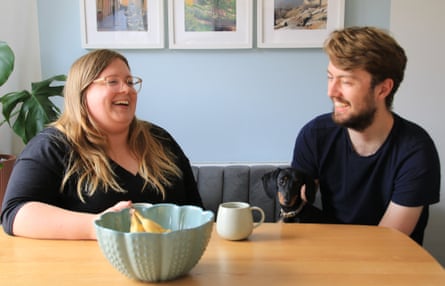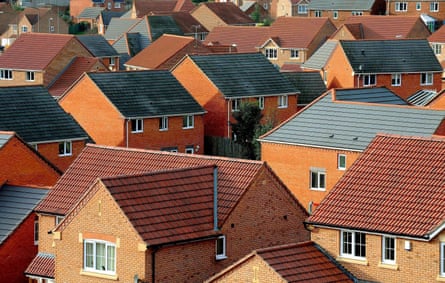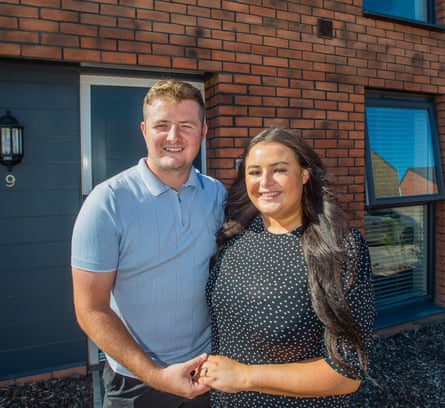Shared ownership is promoted as the low-cost, low-deposit path for first-time buyers to escape the rent trap. But is the part-rent, part-buy model the staircase to heaven or hell?
For Caitlin Bucktrout and her partner, Sam Ward, both 25, it has been heavenly. They picked up the keys to their newly built three-bed semi near Headingley in Leeds in February 2020, just as the coronavirus pandemic threw the country into lockdown.
Their 25% share costs them just under £900 a month (including the rent element and service charges) – or almost exactly the same as the rent they paid on their former two-bed flat. But their new home comes with an extra bedroom, a garden and parking – and they now have their fabled first foot on the property ladder.
“It’s not lost on us how lucky we are. We have a lovely house on a really good corner plot overlooking parkland. We’re both 25 and, of our social group, half are still renting, and the ones that have been able to buy on their own have largely been given money through inheritances,” Caitlin says.
But why did they opt to buy only 25% rather than buy the £250,000 property outright?
The crux of the matter was the deposit. Buying a £250,000 home on the open market typically means raising a deposit of at least £25,000, which is far beyond the means of most young people unable to save as they struggle with high rents and all the other costs of living.
Caitlin and Sam’s shared ownership deal required that they put down a much more affordable minimum deposit of £8,500 (although they chose to add a little more). “We did not have a big deposit, so that meant we had very limited options on the open market,” Caitlin says.
 View image in fullscreenCaitlin Bucktrout and Sam Ward ‘have a lovely house on a really good corner plot overlooking parkland’. Photograph: Leeds Building Society
View image in fullscreenCaitlin Bucktrout and Sam Ward ‘have a lovely house on a really good corner plot overlooking parkland’. Photograph: Leeds Building Society
But while the experience for Caitlin and Sam has been extremely positive, shared ownership is not without its drawbacks.
Even though a buyer owns just a share of the property, they are responsible for all repairs. Many shared ownership properties, particularly in cities, are leasehold flats that come with high service charges. The purchase price is sometimes steeper than similar properties on the open market and, if their circumstances change, buyers are mostly forbidden from subletting the property (although some big housing associations are now more relaxed about this). The mortgage rate on shared ownership homes can also (although not always) be slightly higher than standard purchases.
In recent years shared ownership has been overshadowed by the government’s vast help-to-buy programme. But that will close to new applicants from the end of October, and housing associations and lenders are bracing themselves for a rise in interest in shared ownership as an alternative.
In addition, Shared Ownership Week kicks off on 15 September and runs until 21 September.
So what is shared ownership and how does it work – and should you stand on the sidelines as the expected economic recession next year pulls house prices back from the stratosphere?
What is shared ownership?
You buy a share in the overall value of a home, usually a new-build, and pay a rent and service charge on the rest of it. You can then “staircase” upwards: buying more of the home in chunks as you can afford it. But there is no requirement to buy more.
There are different rules on shared ownership in England, Scotland and Wales (in Northern Ireland there is something similar called co-ownership).
Typically you start with buying a 25% share, although sometimes schemes have a slightly higher minimum level. Under the “new model” shared ownership rules coming in next year, the minimum share falls to 10%, and staircasing can be done in 1% steps.
 View image in fullscreenEven though a buyer only owns a share of the property, they are responsible for all repairs. Photograph: Rui Vieira/PA
View image in fullscreenEven though a buyer only owns a share of the property, they are responsible for all repairs. Photograph: Rui Vieira/PA
How much does it cost?
Generally, the total cost comes in just a little bit less than renting the same property locally.
“We try to ensure overall outgoings are lower that what you would pay for the equivalent in the private rental sector,” says John Lumley, a director of London & Quadrant (L&Q), which manages almost 120,000 properties and is building about 1,000 to 1,500 shared ownership homes annually.
Note that city apartments come with high service charges, which will almost certainly rise every year.
Here are two examples of properties currently for sale on shared ownership.
London: a one-bed, 50 sq metres apartment in Whitechapel, in London’s East End, through L&Q. The open market price is quoted at £500,000. The shared ownership buyer takes 25%, so that’s a £125,000 mortgage likely to cost about £575 a month. The buyer then has to pay monthly rent of £656 on the 75% they don’t own. The monthly service charge is another £258.53.
So that’s a total of £1,490. That sounds quite steep but open market rents for similar one-bedroom properties in the area are about £1,750 to £2,250.
Cornwall: a two-bed end-of-terrace home in Probus, just outside Truro, through LiveWest housing association. The open market price is £250,000. The shared ownership buyer takes 40%, so that’s a £100,000 mortgage likely to cost about £522. The buyer then has to pay monthly rent of £312.50 for the 60% they don’t own. The service charge is £19.76 a month and building insurance is £7.75.
So that’s a total of £862.34 a month. Two-bed house in the area are renting commercially at about £950 to £1,100 a month.
How much deposit do I have to put down?
That’s the core benefit of shared ownership. Typically you will be required to find a deposit equivalent to at least 5% of the share of the property you are buying.
On a £400,000 property, a 25% share is £100,000, and the 5% deposit is £5,000. On the open market, mortgage lenders will typically want a minimum deposit of 5%, so that would be £20,000 on a £400,000 house, but they often recommend you put down 10% – £40,000 in this case – to access sensible mortgage rates.
Are they very picky about who is allowed to buy?
Your total household income must be less than £80,000 (£90,000 in London and £60,000 in Wales). The scheme is intended for first-time buyers, although people who are former owners can also apply. For some schemes you will have to show a connection to the local area.
There is a separate scheme, called older people’s shared ownership, where if you buy 75% of the property there is no rent on the rest.
Do the good deals get snapped up immediately?
It will depend on the area. Debra Saunders of LiveWest, which builds about 300 shared ownership homes a year, says: “Last week we released a scheme in Taunton, Somerset, with eight units. We had 83 applicants in half an hour.”
She says Bristol is particularly “hot” at the moment. Guardian Money found more availability in the London region than in the south-west, where almost all the shared ownership homes we looked at appeared to be “under offer”.
 View image in fullscreenLiveWest’s Debra Saunders says Bristol is particularly ‘hot’ at the moment. Photograph: Karl Newton/Getty Images
View image in fullscreenLiveWest’s Debra Saunders says Bristol is particularly ‘hot’ at the moment. Photograph: Karl Newton/Getty Images
What about a secondhand shared ownership property?
Smart buyers will look for resales, where an existing shared ownership buyer is selling up. These tend to be cheaper because they no longer have the new-build premium in the price. But check how many years are left on the lease because that can cause problems in future. All shared ownerships are done on the controversial leasehold basis, although new ones are likely to have 999-year leases with zero ground rent.
So where do I find shared ownership homes?
Unfortunately, there is no single database. Confusingly, the government’s website directs you to help-to-buy agents, and from there you can search for shared ownership homes. You should also keep an eye on local housing association websites.
Plus Rightmove and Zoopla list resales.
Will the rent shoot up?
It will go up, but according to a formula, not a landlord’s whim. Rents tend to be calculated at between 2% and 2.75% of the value of the share not owned by the buyer. Rents are linked to the Retail Price Index and are generally set according to the RPI in the previous November; L&Q said that discussions are already taking place at a national level with regards to a general strategy and response from the sector for 2023.
Any chance the price includes gas and electricity?
Sorry, we couldn’t find any that included bills.
Can I do what I like to the property?
Yes and no. It is your home, and you don’t have to check with the landlord if you want to repaint the walls. But any significant changes – such as knocking down a wall or adding a conservatory – will need prior approval.
With any home improvements and repairs, you will have to pay 100% of the cost. A housing association may own 75% but it won’t cough up for painting and decorating. However, as most are new-builds, serious repairs should be covered by warranties.
 View image in fullscreenWith a shared ownership property you don’t need to check with the landlord if you want to repaint the walls. Photograph: Kitzcorner/Getty Images/iStockphoto
View image in fullscreenWith a shared ownership property you don’t need to check with the landlord if you want to repaint the walls. Photograph: Kitzcorner/Getty Images/iStockphoto
What if my partner and I break up after a few years. Who pays the rent and mortgage then?
One of the big drawbacks with shared ownership in the past was strict rules that prohibited subletting. So if you lost your job or got divorced, it was often messy.
But Lumley of L&Q says the rules have become more relaxed. “We do allow subletting. Housing associations have always had discretion to permit subletting, and we have interpreted that in the broadest possible way.”
The housing associations are keen to avoid buy to let on the sly. In circumstances of a breakup where the one remaining partner can’t afford the full cost, there are options to reverse staircase – drop the percentage you own – and in exceptional cases a housing association can do a full buyback of the property and just rent it to the former owner.
How do I sell?
This used to be another sticky part of shared ownership. You always had to inform the housing association, and they would try selling the property to another prospective shared ownership buyer. Only if no buyer was found that way could you sell it on the open market.
But owners largely have the freedom, if they wish, to sell via an estate agent (although you can avoid most sale fees if you go through the housing association). It’s also possible, as a 25% owner, to sell 100% of the property – it’s called a back-to-back sale, where a new buyer can buy the entirety of the home.
Will the mortgage be at a stupid interest rate?
No. “The availability of mortgages has increased hugely in recent years,” Lumley says.
Lloyds, Halifax and Barclays all offer shared ownership home loans, with Leeds building society also one of the big players.
The two- and five-year fixes at the Leeds are the same or in some cases even cheaper than its mainstream open market products.
Do I have to pay full stamp duty but only own 25% of the home?
You can choose to just pay stamp duty only on the specific share you are buying. But as a first-time buyer, you typically pay no stamp duty on the first £300,000 in any case.
Will I be trapped if house prices fall?
If you are of the view that house prices are about to collapse (and interest rates are almost certainly marching upwards), then you shouldn’t be entering into shared ownership. It’s worth noting that in a falling market, studio flats in particular may become difficult to sell, as open market buyers will be able to afford larger flats. Shared ownership flats may also be regarded as too much hassle if it is a buyers’ market.
‘I fell in love with it straight away’
Even though pub landlord Jonathan Kaye, 33, was pulling in good money from his job, London’s property prices were always pulling away faster.
What attracted me most to shared ownership was that I only had to put down a £5,000 deposit Jonathan Kaye
“I was renting in London for 11 years. I had a one-bed flat in Haggerston that was costing me £1,820 a month plus bills. When the pandemic happened, I lost my job and lived with my mother instead. I started to realise how much I was sinking in rent.
“But I didn’t want to put all my savings into a deposit, as there was an opportunity for me to launch my own pub in Vauxhall with some childhood friends. What attracted me most to shared ownership was that I only had to put down a £5,000 deposit and have my foot on the property ladder.”
He bought a 25% share of a one-bed apartment valued at £400,000 in Greenwich Square, via the housing association L&Q.
The mortgage on his £100,000 share is £380, while the rent is £650 and the service charge is £380. That’s a total of £1,180 a month – or considerably less than he was paying in Haggerston for rent only.
It has also meant he has had enough left over to help launch the pub, the Jolly Gardeners, which is already a hit with locals.
“I have a lovely one-bed flat on the first floor of an amazing apartment complex with a shared garden, and it’s super-safe. I can paint the place how I like, put pictures up and relax knowing that a landlord is not going to object. I love it,” Jonathan says.
 View image in fullscreenCameron Webb and Jessica Sleight took a 40% share in a three-bed semi that had a full market value of £288,000. Photograph: GRW Photography
View image in fullscreenCameron Webb and Jessica Sleight took a 40% share in a three-bed semi that had a full market value of £288,000. Photograph: GRW Photography
‘We’re both 22 and didn’t think we could ever afford our own home’
When Jessica Sleight and Cameron Webb began looking for a home together, it was soon apparent that there was nothing they could afford in their corner of Devon.
“We had meetings with mortgage advisers and were told the maximum we could get was £188,000. We were looking at Dartmouth, Torquay and Paignton, and there was nothing in that price bracket. We didn’t even think of Exeter because of prices there. And prices kept on rising,” Jessica says.
Then the couple came across LiveWest’s shared ownership scheme. “We applied and got approved fairly quickly but then the race was on to pick a plot on the development, Harrington Park in Exeter. I was literally running up a hill near my dad’s house as I couldn’t get a signal. We wanted plot 27 but that had gone by the time we got through. But we got plot 29, which had an even bigger garden.”
In March the couple took a 40% share in the three-bed semi, which had a full market value of £288,000. They are now paying £445 for the mortgage and £343 for the rent, with a service charge of £160 a year. They had to put down a 5% deposit on their share.
Although Jessica and Cameron have been living with parents while saving for a deposit, they say their friends are paying almost £900 a month for rental flats in Torquay. “We knew that if we started renting, we’d never stop, as we could never save.
“It’s a lovely estate, and you’d never know it was shared ownership. There are open market homes on the estate as well, and some people have Range Rovers. When we started out, we always knew we wanted to go down the new-build route. Neither of us are very handy.”
This article was amended on 27 September 2022 to add information about the function of the Retail Price Index in relation to the setting of rents.





Leave a Reply
You must be logged in to post a comment.